CHC30113/CHC50113 CHCDIV001: Diversity Case Scenarios Report
VerifiedAdded on 2023/01/03
|11
|3590
|72
Report
AI Summary
This report, prepared by a student, addresses three case scenarios related to diversity within an early childhood education and care context, specifically for the CHCDIV001 unit. The report meticulously examines each scenario, providing detailed responses that cover legal and statutory requirements, relevant policies and procedures, and available support systems. It explores the human rights of children and families involved, analyzes various options from different perspectives, and proposes specific actions to be taken. The report also outlines how these actions would be implemented, including communication strategies, and anticipates the potential outcomes of these interventions. The scenarios involve issues of religious differences, cultural integration of a new migrant child, and a child impacted by trauma. The report emphasizes the importance of respecting diversity, promoting tolerance, and providing appropriate support to children and families in diverse situations. The report adheres to the assessment criteria and includes a cover sheet and a case scenario template, ensuring a comprehensive and structured approach to the analysis of each case.
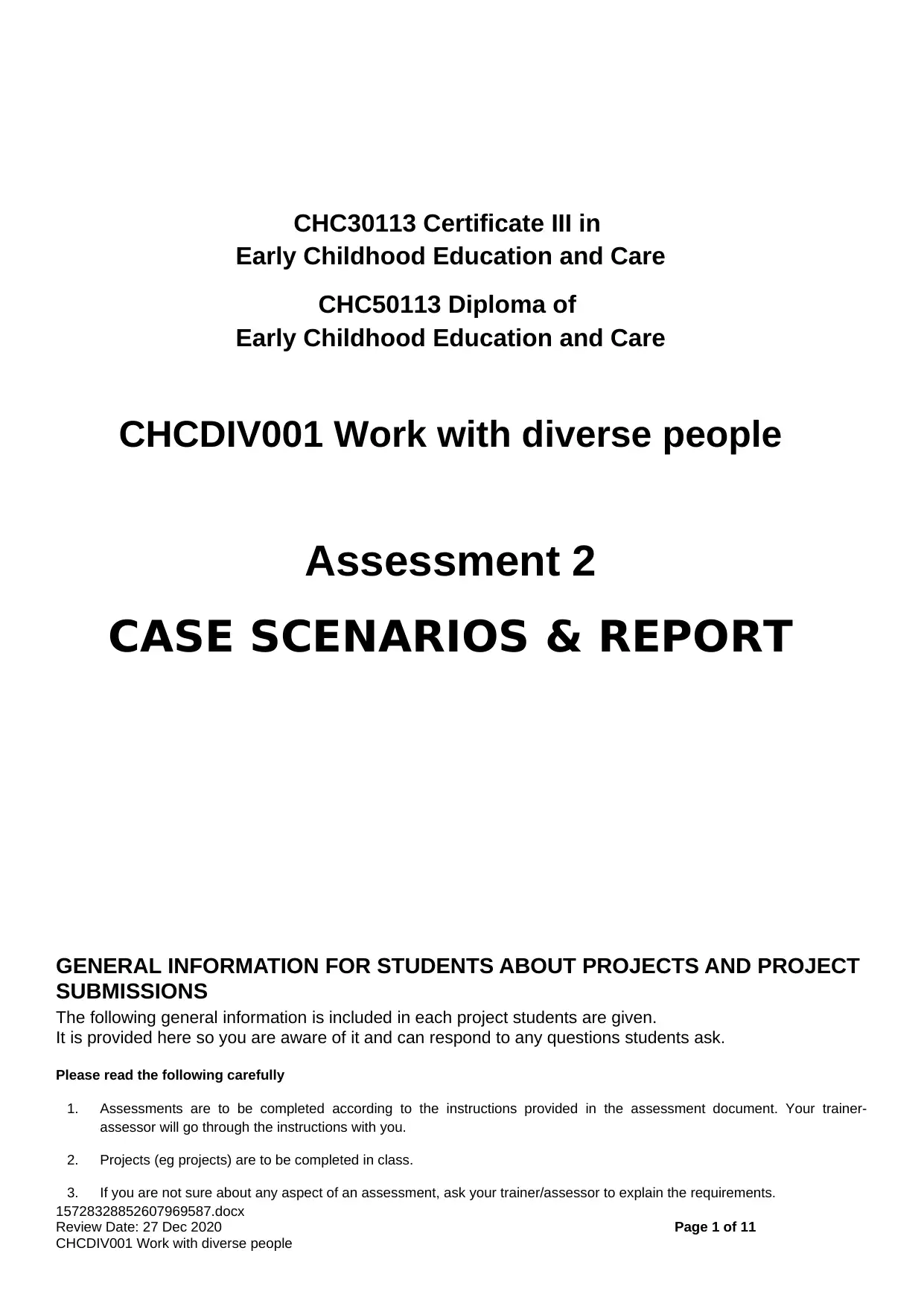
GENERAL INFORMATION FOR STUDENTS ABOUT PROJECTS AND PROJECT
SUBMISSIONS
The following general information is included in each project students are given.
It is provided here so you are aware of it and can respond to any questions students ask.
Please read the following carefully
1. Assessments are to be completed according to the instructions provided in the assessment document. Your trainer-
assessor will go through the instructions with you.
2. Projects (eg projects) are to be completed in class.
3. If you are not sure about any aspect of an assessment, ask your trainer/assessor to explain the requirements.
15728328852607969587.docx
Review Date: 27 Dec 2020 Page 1 of 11
CHCDIV001 Work with diverse people
CHC30113 Certificate III in
Early Childhood Education and Care
CHC50113 Diploma of
Early Childhood Education and Care
CHCDIV001 Work with diverse people
Assessment 2
CASE SCENARIOS & REPORT
SUBMISSIONS
The following general information is included in each project students are given.
It is provided here so you are aware of it and can respond to any questions students ask.
Please read the following carefully
1. Assessments are to be completed according to the instructions provided in the assessment document. Your trainer-
assessor will go through the instructions with you.
2. Projects (eg projects) are to be completed in class.
3. If you are not sure about any aspect of an assessment, ask your trainer/assessor to explain the requirements.
15728328852607969587.docx
Review Date: 27 Dec 2020 Page 1 of 11
CHCDIV001 Work with diverse people
CHC30113 Certificate III in
Early Childhood Education and Care
CHC50113 Diploma of
Early Childhood Education and Care
CHCDIV001 Work with diverse people
Assessment 2
CASE SCENARIOS & REPORT
Paraphrase This Document
Need a fresh take? Get an instant paraphrase of this document with our AI Paraphraser
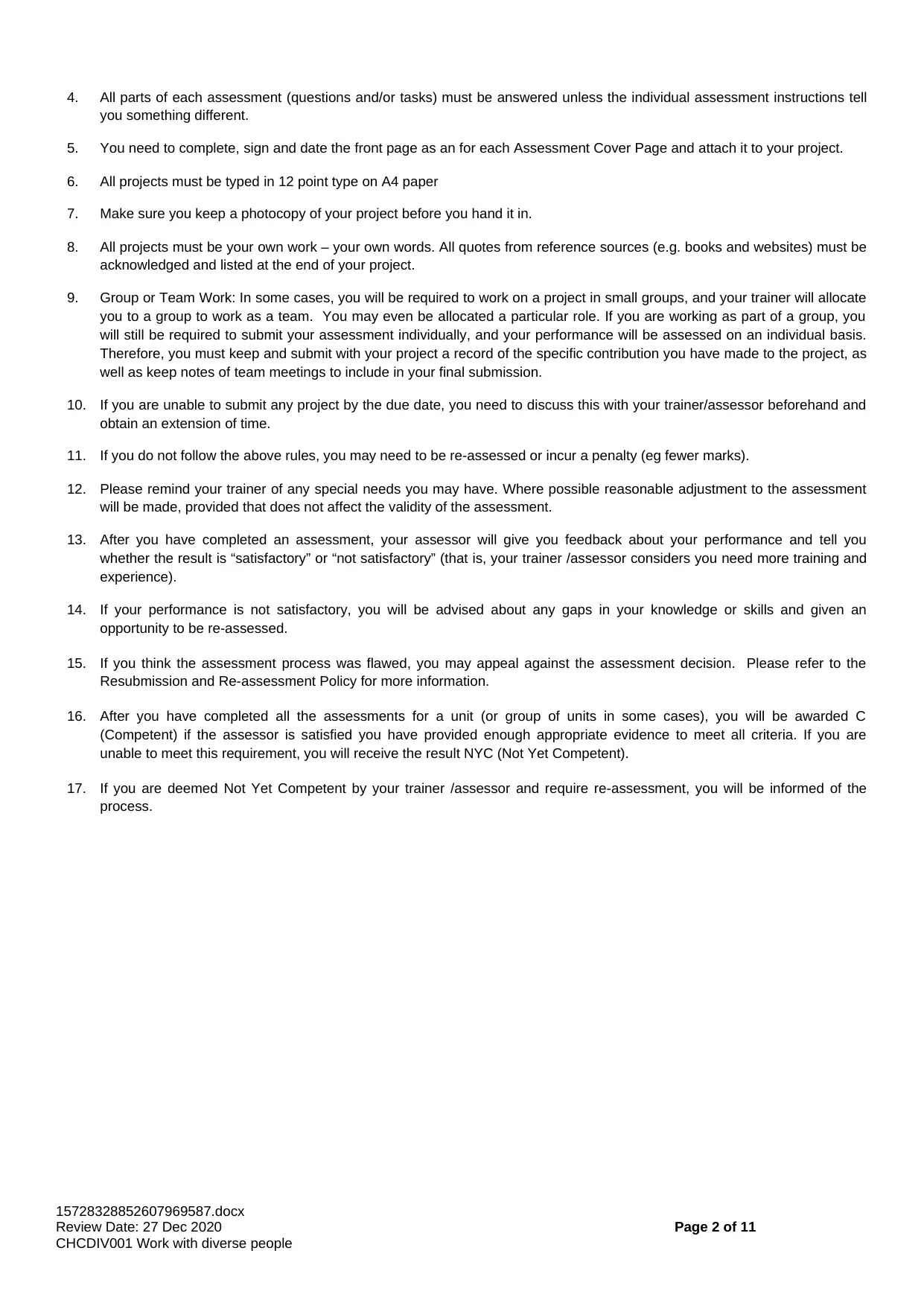
4. All parts of each assessment (questions and/or tasks) must be answered unless the individual assessment instructions tell
you something different.
5. You need to complete, sign and date the front page as an for each Assessment Cover Page and attach it to your project.
6. All projects must be typed in 12 point type on A4 paper
7. Make sure you keep a photocopy of your project before you hand it in.
8. All projects must be your own work – your own words. All quotes from reference sources (e.g. books and websites) must be
acknowledged and listed at the end of your project.
9. Group or Team Work: In some cases, you will be required to work on a project in small groups, and your trainer will allocate
you to a group to work as a team. You may even be allocated a particular role. If you are working as part of a group, you
will still be required to submit your assessment individually, and your performance will be assessed on an individual basis.
Therefore, you must keep and submit with your project a record of the specific contribution you have made to the project, as
well as keep notes of team meetings to include in your final submission.
10. If you are unable to submit any project by the due date, you need to discuss this with your trainer/assessor beforehand and
obtain an extension of time.
11. If you do not follow the above rules, you may need to be re-assessed or incur a penalty (eg fewer marks).
12. Please remind your trainer of any special needs you may have. Where possible reasonable adjustment to the assessment
will be made, provided that does not affect the validity of the assessment.
13. After you have completed an assessment, your assessor will give you feedback about your performance and tell you
whether the result is “satisfactory” or “not satisfactory” (that is, your trainer /assessor considers you need more training and
experience).
14. If your performance is not satisfactory, you will be advised about any gaps in your knowledge or skills and given an
opportunity to be re-assessed.
15. If you think the assessment process was flawed, you may appeal against the assessment decision. Please refer to the
Resubmission and Re-assessment Policy for more information.
16. After you have completed all the assessments for a unit (or group of units in some cases), you will be awarded C
(Competent) if the assessor is satisfied you have provided enough appropriate evidence to meet all criteria. If you are
unable to meet this requirement, you will receive the result NYC (Not Yet Competent).
17. If you are deemed Not Yet Competent by your trainer /assessor and require re-assessment, you will be informed of the
process.
15728328852607969587.docx
Review Date: 27 Dec 2020 Page 2 of 11
CHCDIV001 Work with diverse people
you something different.
5. You need to complete, sign and date the front page as an for each Assessment Cover Page and attach it to your project.
6. All projects must be typed in 12 point type on A4 paper
7. Make sure you keep a photocopy of your project before you hand it in.
8. All projects must be your own work – your own words. All quotes from reference sources (e.g. books and websites) must be
acknowledged and listed at the end of your project.
9. Group or Team Work: In some cases, you will be required to work on a project in small groups, and your trainer will allocate
you to a group to work as a team. You may even be allocated a particular role. If you are working as part of a group, you
will still be required to submit your assessment individually, and your performance will be assessed on an individual basis.
Therefore, you must keep and submit with your project a record of the specific contribution you have made to the project, as
well as keep notes of team meetings to include in your final submission.
10. If you are unable to submit any project by the due date, you need to discuss this with your trainer/assessor beforehand and
obtain an extension of time.
11. If you do not follow the above rules, you may need to be re-assessed or incur a penalty (eg fewer marks).
12. Please remind your trainer of any special needs you may have. Where possible reasonable adjustment to the assessment
will be made, provided that does not affect the validity of the assessment.
13. After you have completed an assessment, your assessor will give you feedback about your performance and tell you
whether the result is “satisfactory” or “not satisfactory” (that is, your trainer /assessor considers you need more training and
experience).
14. If your performance is not satisfactory, you will be advised about any gaps in your knowledge or skills and given an
opportunity to be re-assessed.
15. If you think the assessment process was flawed, you may appeal against the assessment decision. Please refer to the
Resubmission and Re-assessment Policy for more information.
16. After you have completed all the assessments for a unit (or group of units in some cases), you will be awarded C
(Competent) if the assessor is satisfied you have provided enough appropriate evidence to meet all criteria. If you are
unable to meet this requirement, you will receive the result NYC (Not Yet Competent).
17. If you are deemed Not Yet Competent by your trainer /assessor and require re-assessment, you will be informed of the
process.
15728328852607969587.docx
Review Date: 27 Dec 2020 Page 2 of 11
CHCDIV001 Work with diverse people
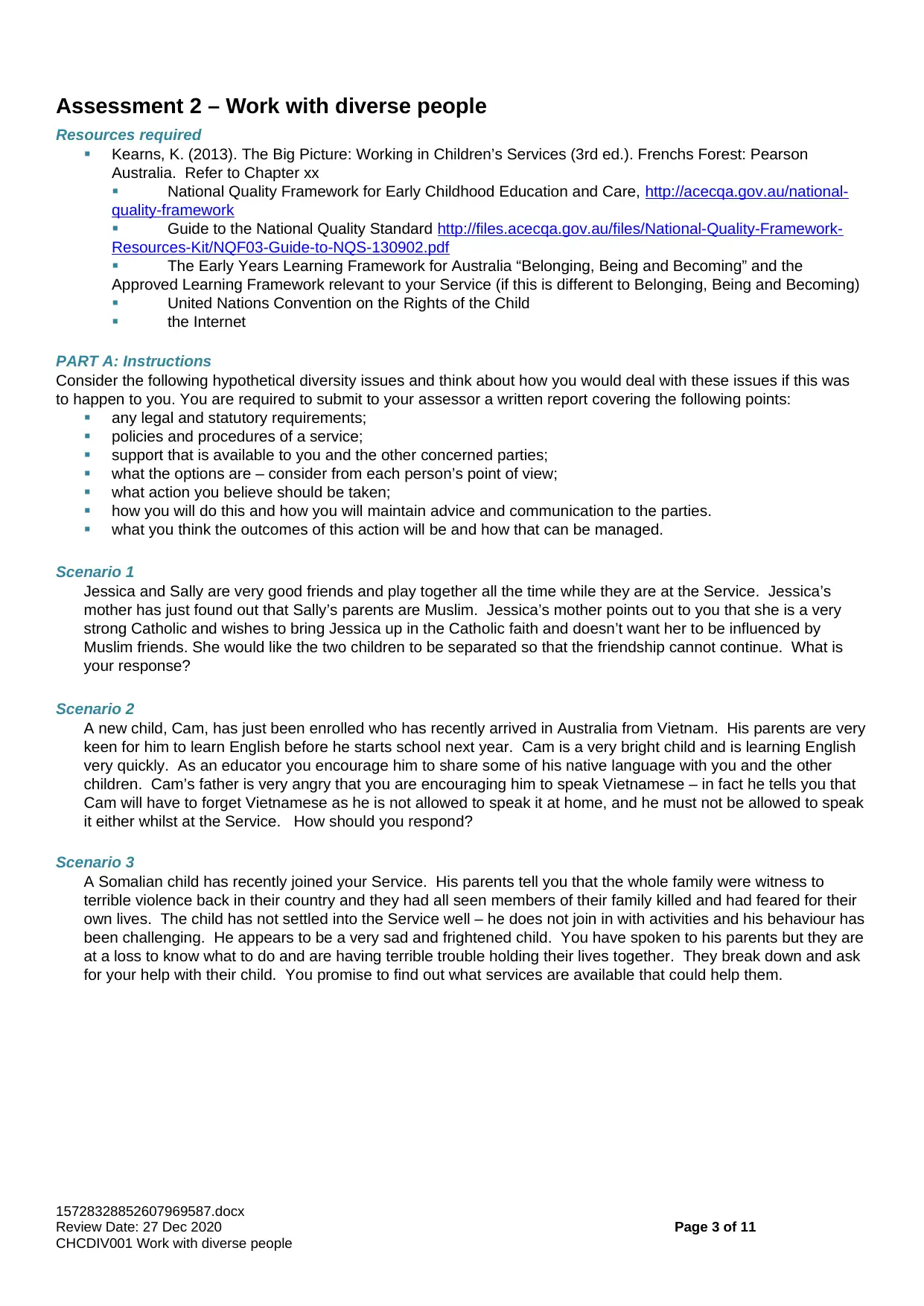
Assessment 2 – Work with diverse people
Resources required
Kearns, K. (2013). The Big Picture: Working in Children’s Services (3rd ed.). Frenchs Forest: Pearson
Australia. Refer to Chapter xx
National Quality Framework for Early Childhood Education and Care, http://acecqa.gov.au/national-
quality-framework
Guide to the National Quality Standard http://files.acecqa.gov.au/files/National-Quality-Framework-
Resources-Kit/NQF03-Guide-to-NQS-130902.pdf
The Early Years Learning Framework for Australia “Belonging, Being and Becoming” and the
Approved Learning Framework relevant to your Service (if this is different to Belonging, Being and Becoming)
United Nations Convention on the Rights of the Child
the Internet
PART A: Instructions
Consider the following hypothetical diversity issues and think about how you would deal with these issues if this was
to happen to you. You are required to submit to your assessor a written report covering the following points:
any legal and statutory requirements;
policies and procedures of a service;
support that is available to you and the other concerned parties;
what the options are – consider from each person’s point of view;
what action you believe should be taken;
how you will do this and how you will maintain advice and communication to the parties.
what you think the outcomes of this action will be and how that can be managed.
Scenario 1
Jessica and Sally are very good friends and play together all the time while they are at the Service. Jessica’s
mother has just found out that Sally’s parents are Muslim. Jessica’s mother points out to you that she is a very
strong Catholic and wishes to bring Jessica up in the Catholic faith and doesn’t want her to be influenced by
Muslim friends. She would like the two children to be separated so that the friendship cannot continue. What is
your response?
Scenario 2
A new child, Cam, has just been enrolled who has recently arrived in Australia from Vietnam. His parents are very
keen for him to learn English before he starts school next year. Cam is a very bright child and is learning English
very quickly. As an educator you encourage him to share some of his native language with you and the other
children. Cam’s father is very angry that you are encouraging him to speak Vietnamese – in fact he tells you that
Cam will have to forget Vietnamese as he is not allowed to speak it at home, and he must not be allowed to speak
it either whilst at the Service. How should you respond?
Scenario 3
A Somalian child has recently joined your Service. His parents tell you that the whole family were witness to
terrible violence back in their country and they had all seen members of their family killed and had feared for their
own lives. The child has not settled into the Service well – he does not join in with activities and his behaviour has
been challenging. He appears to be a very sad and frightened child. You have spoken to his parents but they are
at a loss to know what to do and are having terrible trouble holding their lives together. They break down and ask
for your help with their child. You promise to find out what services are available that could help them.
15728328852607969587.docx
Review Date: 27 Dec 2020 Page 3 of 11
CHCDIV001 Work with diverse people
Resources required
Kearns, K. (2013). The Big Picture: Working in Children’s Services (3rd ed.). Frenchs Forest: Pearson
Australia. Refer to Chapter xx
National Quality Framework for Early Childhood Education and Care, http://acecqa.gov.au/national-
quality-framework
Guide to the National Quality Standard http://files.acecqa.gov.au/files/National-Quality-Framework-
Resources-Kit/NQF03-Guide-to-NQS-130902.pdf
The Early Years Learning Framework for Australia “Belonging, Being and Becoming” and the
Approved Learning Framework relevant to your Service (if this is different to Belonging, Being and Becoming)
United Nations Convention on the Rights of the Child
the Internet
PART A: Instructions
Consider the following hypothetical diversity issues and think about how you would deal with these issues if this was
to happen to you. You are required to submit to your assessor a written report covering the following points:
any legal and statutory requirements;
policies and procedures of a service;
support that is available to you and the other concerned parties;
what the options are – consider from each person’s point of view;
what action you believe should be taken;
how you will do this and how you will maintain advice and communication to the parties.
what you think the outcomes of this action will be and how that can be managed.
Scenario 1
Jessica and Sally are very good friends and play together all the time while they are at the Service. Jessica’s
mother has just found out that Sally’s parents are Muslim. Jessica’s mother points out to you that she is a very
strong Catholic and wishes to bring Jessica up in the Catholic faith and doesn’t want her to be influenced by
Muslim friends. She would like the two children to be separated so that the friendship cannot continue. What is
your response?
Scenario 2
A new child, Cam, has just been enrolled who has recently arrived in Australia from Vietnam. His parents are very
keen for him to learn English before he starts school next year. Cam is a very bright child and is learning English
very quickly. As an educator you encourage him to share some of his native language with you and the other
children. Cam’s father is very angry that you are encouraging him to speak Vietnamese – in fact he tells you that
Cam will have to forget Vietnamese as he is not allowed to speak it at home, and he must not be allowed to speak
it either whilst at the Service. How should you respond?
Scenario 3
A Somalian child has recently joined your Service. His parents tell you that the whole family were witness to
terrible violence back in their country and they had all seen members of their family killed and had feared for their
own lives. The child has not settled into the Service well – he does not join in with activities and his behaviour has
been challenging. He appears to be a very sad and frightened child. You have spoken to his parents but they are
at a loss to know what to do and are having terrible trouble holding their lives together. They break down and ask
for your help with their child. You promise to find out what services are available that could help them.
15728328852607969587.docx
Review Date: 27 Dec 2020 Page 3 of 11
CHCDIV001 Work with diverse people
⊘ This is a preview!⊘
Do you want full access?
Subscribe today to unlock all pages.

Trusted by 1+ million students worldwide
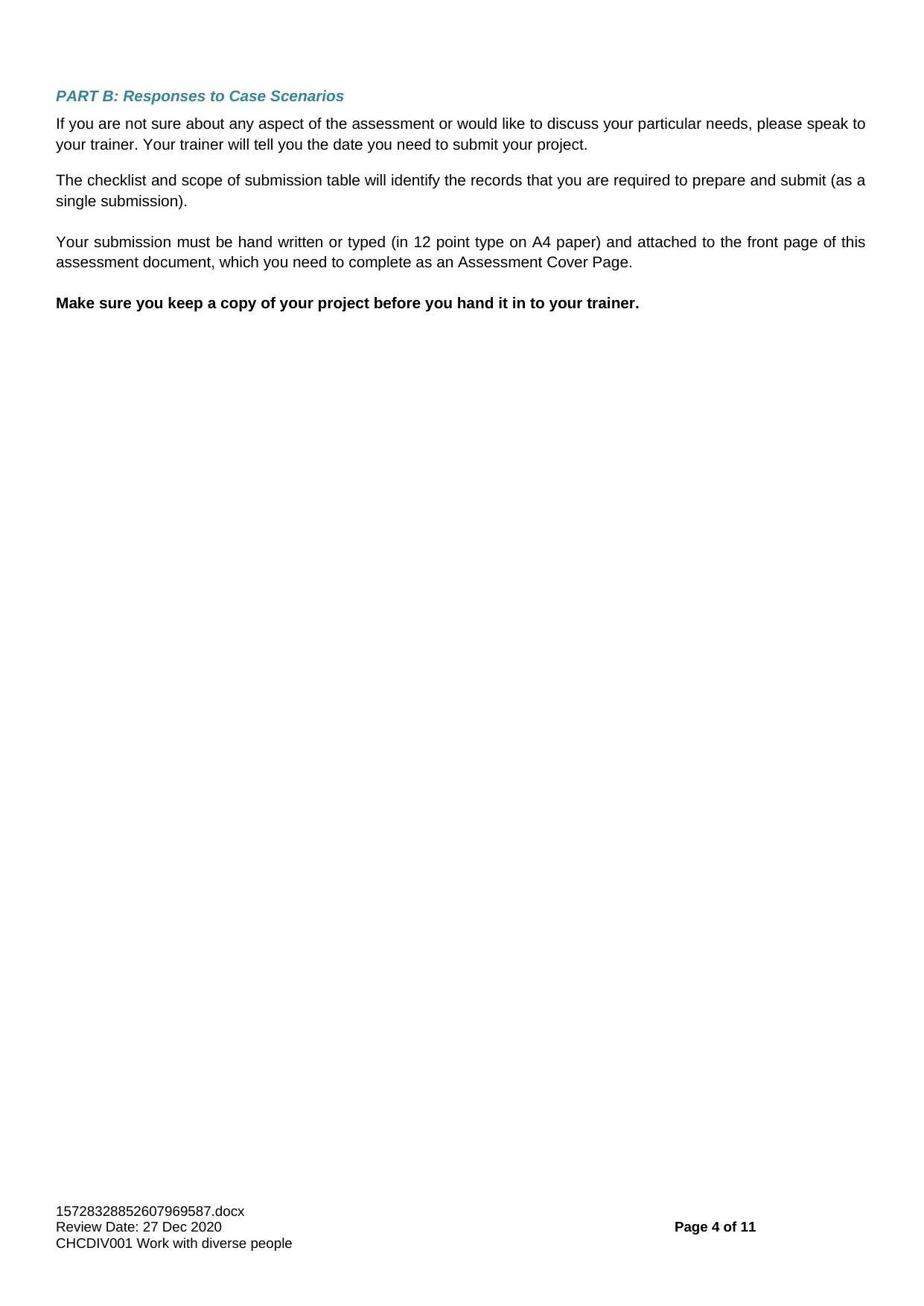
PART B: Responses to Case Scenarios
If you are not sure about any aspect of the assessment or would like to discuss your particular needs, please speak to
your trainer. Your trainer will tell you the date you need to submit your project.
The checklist and scope of submission table will identify the records that you are required to prepare and submit (as a
single submission).
Your submission must be hand written or typed (in 12 point type on A4 paper) and attached to the front page of this
assessment document, which you need to complete as an Assessment Cover Page.
Make sure you keep a copy of your project before you hand it in to your trainer.
15728328852607969587.docx
Review Date: 27 Dec 2020 Page 4 of 11
CHCDIV001 Work with diverse people
If you are not sure about any aspect of the assessment or would like to discuss your particular needs, please speak to
your trainer. Your trainer will tell you the date you need to submit your project.
The checklist and scope of submission table will identify the records that you are required to prepare and submit (as a
single submission).
Your submission must be hand written or typed (in 12 point type on A4 paper) and attached to the front page of this
assessment document, which you need to complete as an Assessment Cover Page.
Make sure you keep a copy of your project before you hand it in to your trainer.
15728328852607969587.docx
Review Date: 27 Dec 2020 Page 4 of 11
CHCDIV001 Work with diverse people
Paraphrase This Document
Need a fresh take? Get an instant paraphrase of this document with our AI Paraphraser
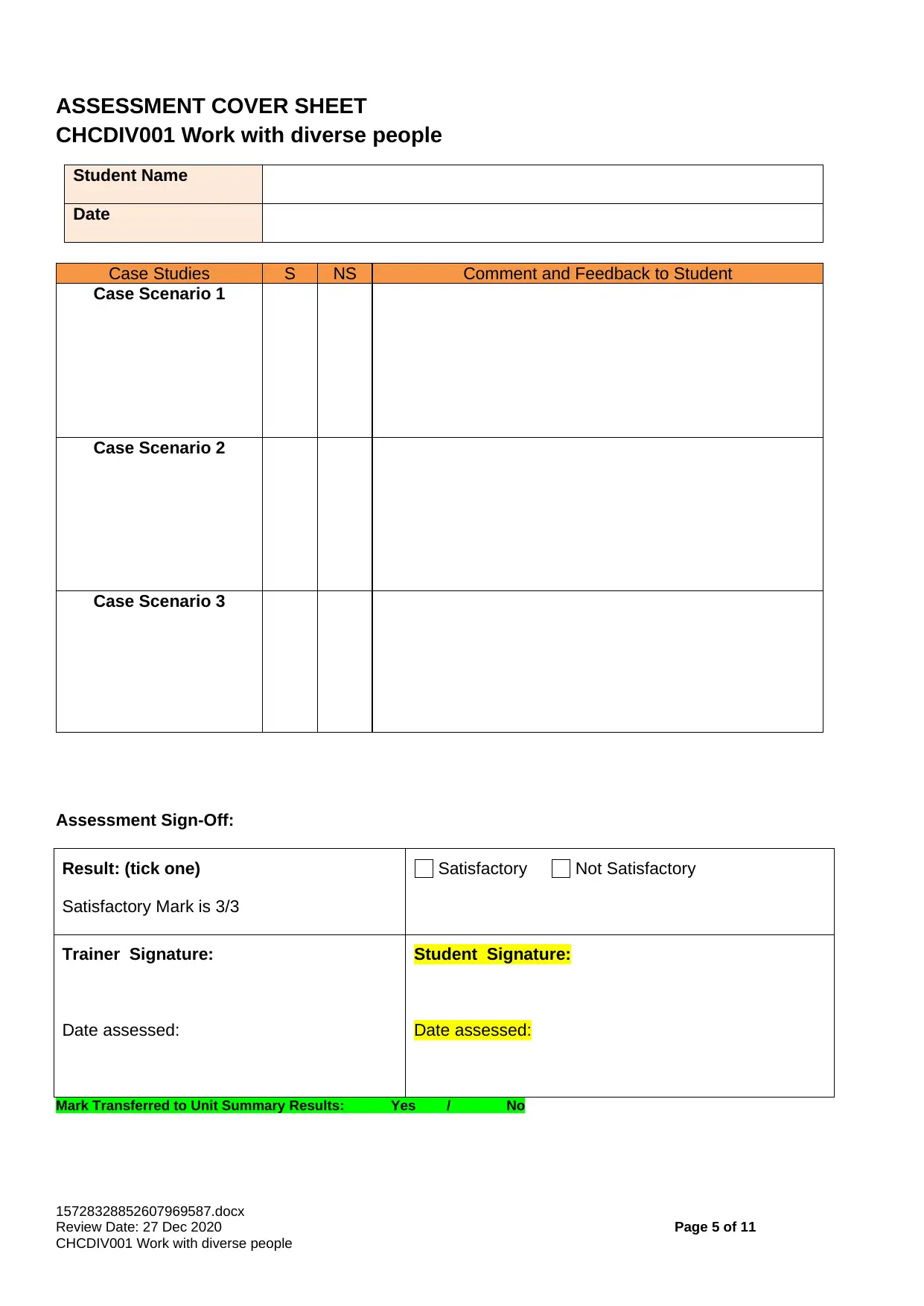
ASSESSMENT COVER SHEET
CHCDIV001 Work with diverse people
Student Name
Date
Case Studies S NS Comment and Feedback to Student
Case Scenario 1
Case Scenario 2
Case Scenario 3
Assessment Sign-Off:
Result: (tick one)
Satisfactory Mark is 3/3
Satisfactory Not Satisfactory
Trainer Signature:
Date assessed:
Student Signature:
Date assessed:
Mark Transferred to Unit Summary Results: Yes / No
15728328852607969587.docx
Review Date: 27 Dec 2020 Page 5 of 11
CHCDIV001 Work with diverse people
CHCDIV001 Work with diverse people
Student Name
Date
Case Studies S NS Comment and Feedback to Student
Case Scenario 1
Case Scenario 2
Case Scenario 3
Assessment Sign-Off:
Result: (tick one)
Satisfactory Mark is 3/3
Satisfactory Not Satisfactory
Trainer Signature:
Date assessed:
Student Signature:
Date assessed:
Mark Transferred to Unit Summary Results: Yes / No
15728328852607969587.docx
Review Date: 27 Dec 2020 Page 5 of 11
CHCDIV001 Work with diverse people
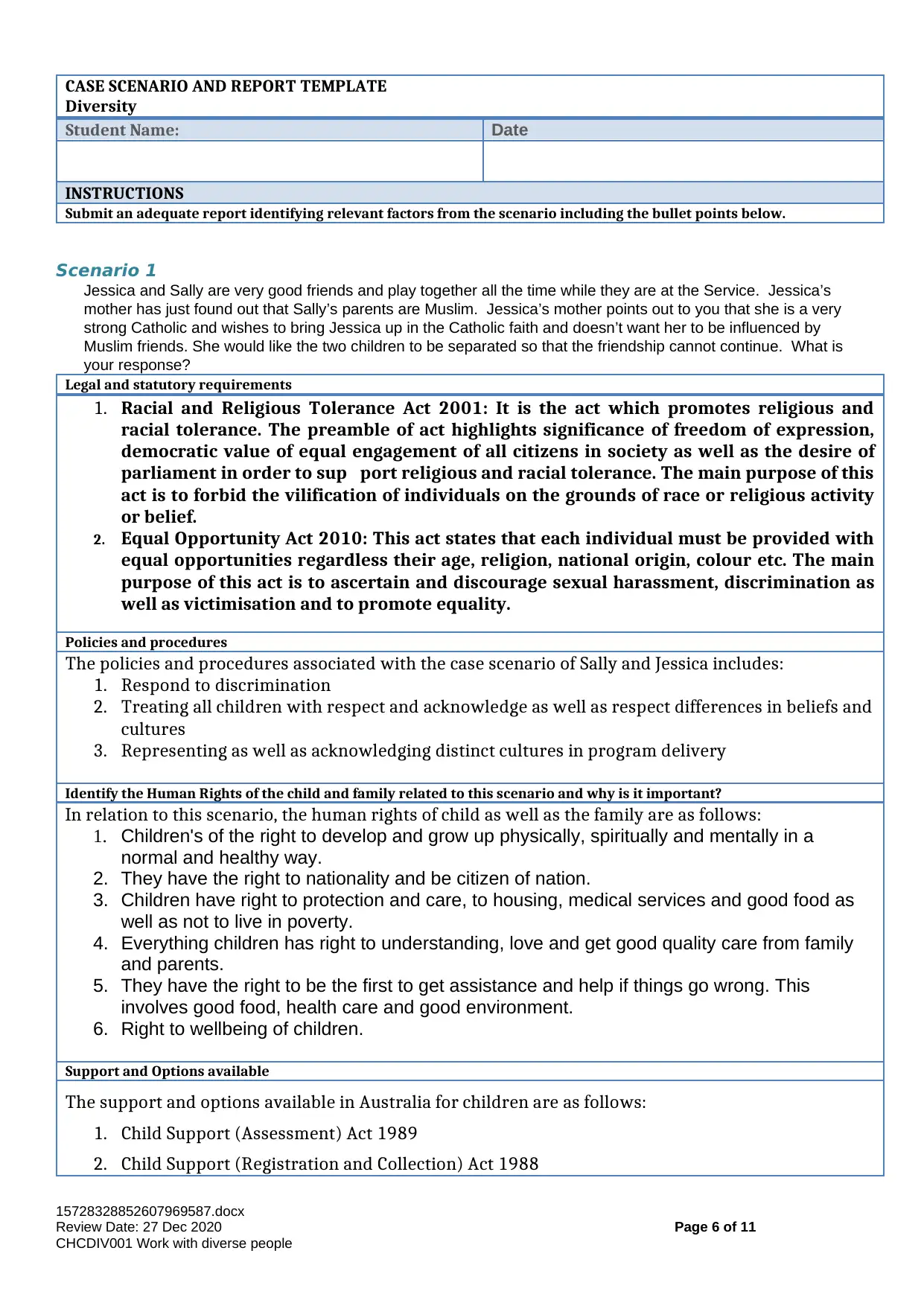
CASE SCENARIO AND REPORT TEMPLATE
Diversity
Student Name: Date
INSTRUCTIONS
Submit an adequate report identifying relevant factors from the scenario including the bullet points below.
Scenario 1
Jessica and Sally are very good friends and play together all the time while they are at the Service. Jessica’s
mother has just found out that Sally’s parents are Muslim. Jessica’s mother points out to you that she is a very
strong Catholic and wishes to bring Jessica up in the Catholic faith and doesn’t want her to be influenced by
Muslim friends. She would like the two children to be separated so that the friendship cannot continue. What is
your response?
Legal and statutory requirements
1. Racial and Religious Tolerance Act 2001: It is the act which promotes religious and
racial tolerance. The preamble of act highlights significance of freedom of expression,
democratic value of equal engagement of all citizens in society as well as the desire of
parliament in order to sup port religious and racial tolerance. The main purpose of this
act is to forbid the vilification of individuals on the grounds of race or religious activity
or belief.
2. Equal Opportunity Act 2010: This act states that each individual must be provided with
equal opportunities regardless their age, religion, national origin, colour etc. The main
purpose of this act is to ascertain and discourage sexual harassment, discrimination as
well as victimisation and to promote equality.
Policies and procedures
The policies and procedures associated with the case scenario of Sally and Jessica includes:
1. Respond to discrimination
2. Treating all children with respect and acknowledge as well as respect differences in beliefs and
cultures
3. Representing as well as acknowledging distinct cultures in program delivery
Identify the Human Rights of the child and family related to this scenario and why is it important?
In relation to this scenario, the human rights of child as well as the family are as follows:
1. Children's of the right to develop and grow up physically, spiritually and mentally in a
normal and healthy way.
2. They have the right to nationality and be citizen of nation.
3. Children have right to protection and care, to housing, medical services and good food as
well as not to live in poverty.
4. Everything children has right to understanding, love and get good quality care from family
and parents.
5. They have the right to be the first to get assistance and help if things go wrong. This
involves good food, health care and good environment.
6. Right to wellbeing of children.
Support and Options available
The support and options available in Australia for children are as follows:
1. Child Support (Assessment) Act 1989
2. Child Support (Registration and Collection) Act 1988
15728328852607969587.docx
Review Date: 27 Dec 2020 Page 6 of 11
CHCDIV001 Work with diverse people
Diversity
Student Name: Date
INSTRUCTIONS
Submit an adequate report identifying relevant factors from the scenario including the bullet points below.
Scenario 1
Jessica and Sally are very good friends and play together all the time while they are at the Service. Jessica’s
mother has just found out that Sally’s parents are Muslim. Jessica’s mother points out to you that she is a very
strong Catholic and wishes to bring Jessica up in the Catholic faith and doesn’t want her to be influenced by
Muslim friends. She would like the two children to be separated so that the friendship cannot continue. What is
your response?
Legal and statutory requirements
1. Racial and Religious Tolerance Act 2001: It is the act which promotes religious and
racial tolerance. The preamble of act highlights significance of freedom of expression,
democratic value of equal engagement of all citizens in society as well as the desire of
parliament in order to sup port religious and racial tolerance. The main purpose of this
act is to forbid the vilification of individuals on the grounds of race or religious activity
or belief.
2. Equal Opportunity Act 2010: This act states that each individual must be provided with
equal opportunities regardless their age, religion, national origin, colour etc. The main
purpose of this act is to ascertain and discourage sexual harassment, discrimination as
well as victimisation and to promote equality.
Policies and procedures
The policies and procedures associated with the case scenario of Sally and Jessica includes:
1. Respond to discrimination
2. Treating all children with respect and acknowledge as well as respect differences in beliefs and
cultures
3. Representing as well as acknowledging distinct cultures in program delivery
Identify the Human Rights of the child and family related to this scenario and why is it important?
In relation to this scenario, the human rights of child as well as the family are as follows:
1. Children's of the right to develop and grow up physically, spiritually and mentally in a
normal and healthy way.
2. They have the right to nationality and be citizen of nation.
3. Children have right to protection and care, to housing, medical services and good food as
well as not to live in poverty.
4. Everything children has right to understanding, love and get good quality care from family
and parents.
5. They have the right to be the first to get assistance and help if things go wrong. This
involves good food, health care and good environment.
6. Right to wellbeing of children.
Support and Options available
The support and options available in Australia for children are as follows:
1. Child Support (Assessment) Act 1989
2. Child Support (Registration and Collection) Act 1988
15728328852607969587.docx
Review Date: 27 Dec 2020 Page 6 of 11
CHCDIV001 Work with diverse people
⊘ This is a preview!⊘
Do you want full access?
Subscribe today to unlock all pages.

Trusted by 1+ million students worldwide
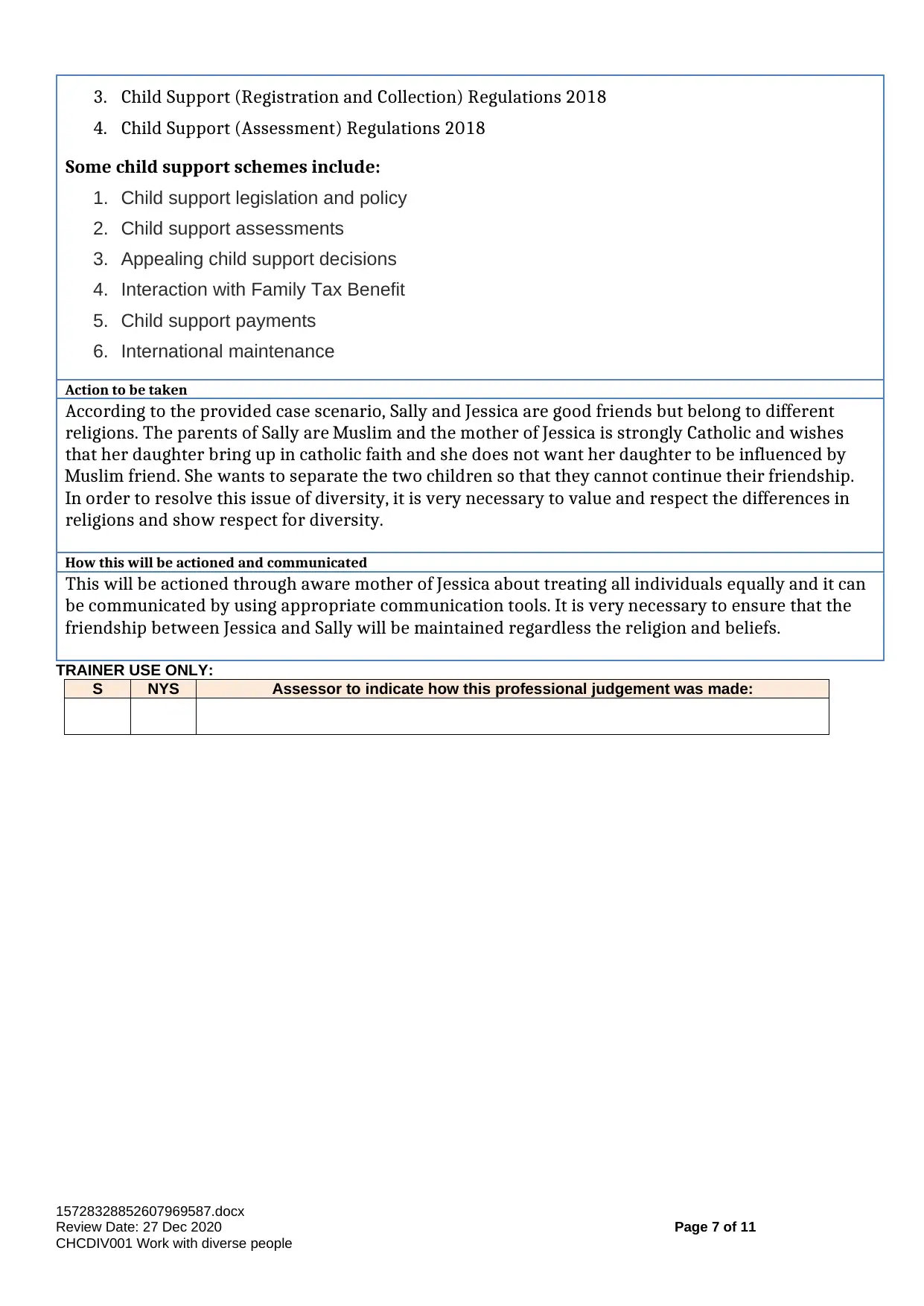
3. Child Support (Registration and Collection) Regulations 2018
4. Child Support (Assessment) Regulations 2018
Some child support schemes include:
1. Child support legislation and policy
2. Child support assessments
3. Appealing child support decisions
4. Interaction with Family Tax Benefit
5. Child support payments
6. International maintenance
Action to be taken
According to the provided case scenario, Sally and Jessica are good friends but belong to different
religions. The parents of Sally are Muslim and the mother of Jessica is strongly Catholic and wishes
that her daughter bring up in catholic faith and she does not want her daughter to be influenced by
Muslim friend. She wants to separate the two children so that they cannot continue their friendship.
In order to resolve this issue of diversity, it is very necessary to value and respect the differences in
religions and show respect for diversity.
How this will be actioned and communicated
This will be actioned through aware mother of Jessica about treating all individuals equally and it can
be communicated by using appropriate communication tools. It is very necessary to ensure that the
friendship between Jessica and Sally will be maintained regardless the religion and beliefs.
TRAINER USE ONLY:
S NYS Assessor to indicate how this professional judgement was made:
15728328852607969587.docx
Review Date: 27 Dec 2020 Page 7 of 11
CHCDIV001 Work with diverse people
4. Child Support (Assessment) Regulations 2018
Some child support schemes include:
1. Child support legislation and policy
2. Child support assessments
3. Appealing child support decisions
4. Interaction with Family Tax Benefit
5. Child support payments
6. International maintenance
Action to be taken
According to the provided case scenario, Sally and Jessica are good friends but belong to different
religions. The parents of Sally are Muslim and the mother of Jessica is strongly Catholic and wishes
that her daughter bring up in catholic faith and she does not want her daughter to be influenced by
Muslim friend. She wants to separate the two children so that they cannot continue their friendship.
In order to resolve this issue of diversity, it is very necessary to value and respect the differences in
religions and show respect for diversity.
How this will be actioned and communicated
This will be actioned through aware mother of Jessica about treating all individuals equally and it can
be communicated by using appropriate communication tools. It is very necessary to ensure that the
friendship between Jessica and Sally will be maintained regardless the religion and beliefs.
TRAINER USE ONLY:
S NYS Assessor to indicate how this professional judgement was made:
15728328852607969587.docx
Review Date: 27 Dec 2020 Page 7 of 11
CHCDIV001 Work with diverse people
Paraphrase This Document
Need a fresh take? Get an instant paraphrase of this document with our AI Paraphraser
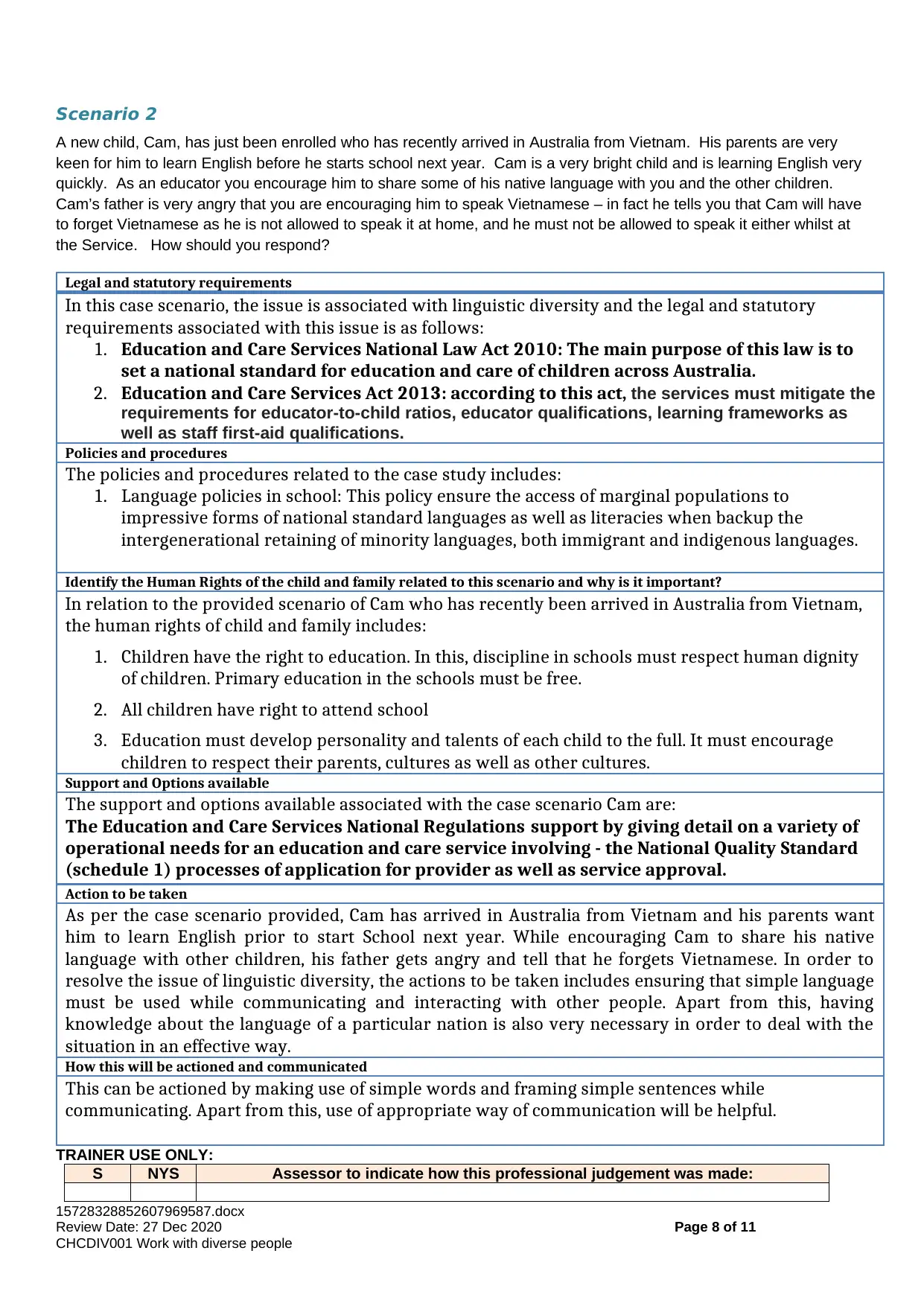
Scenario 2
A new child, Cam, has just been enrolled who has recently arrived in Australia from Vietnam. His parents are very
keen for him to learn English before he starts school next year. Cam is a very bright child and is learning English very
quickly. As an educator you encourage him to share some of his native language with you and the other children.
Cam’s father is very angry that you are encouraging him to speak Vietnamese – in fact he tells you that Cam will have
to forget Vietnamese as he is not allowed to speak it at home, and he must not be allowed to speak it either whilst at
the Service. How should you respond?
Legal and statutory requirements
In this case scenario, the issue is associated with linguistic diversity and the legal and statutory
requirements associated with this issue is as follows:
1. Education and Care Services National Law Act 2010: The main purpose of this law is to
set a national standard for education and care of children across Australia.
2. Education and Care Services Act 2013: according to this act, the services must mitigate the
requirements for educator-to-child ratios, educator qualifications, learning frameworks as
well as staff first-aid qualifications.
Policies and procedures
The policies and procedures related to the case study includes:
1. Language policies in school: This policy ensure the access of marginal populations to
impressive forms of national standard languages as well as literacies when backup the
intergenerational retaining of minority languages, both immigrant and indigenous languages.
Identify the Human Rights of the child and family related to this scenario and why is it important?
In relation to the provided scenario of Cam who has recently been arrived in Australia from Vietnam,
the human rights of child and family includes:
1. Children have the right to education. In this, discipline in schools must respect human dignity
of children. Primary education in the schools must be free.
2. All children have right to attend school
3. Education must develop personality and talents of each child to the full. It must encourage
children to respect their parents, cultures as well as other cultures.
Support and Options available
The support and options available associated with the case scenario Cam are:
The Education and Care Services National Regulations support by giving detail on a variety of
operational needs for an education and care service involving - the National Quality Standard
(schedule 1) processes of application for provider as well as service approval.
Action to be taken
As per the case scenario provided, Cam has arrived in Australia from Vietnam and his parents want
him to learn English prior to start School next year. While encouraging Cam to share his native
language with other children, his father gets angry and tell that he forgets Vietnamese. In order to
resolve the issue of linguistic diversity, the actions to be taken includes ensuring that simple language
must be used while communicating and interacting with other people. Apart from this, having
knowledge about the language of a particular nation is also very necessary in order to deal with the
situation in an effective way.
How this will be actioned and communicated
This can be actioned by making use of simple words and framing simple sentences while
communicating. Apart from this, use of appropriate way of communication will be helpful.
TRAINER USE ONLY:
S NYS Assessor to indicate how this professional judgement was made:
15728328852607969587.docx
Review Date: 27 Dec 2020 Page 8 of 11
CHCDIV001 Work with diverse people
A new child, Cam, has just been enrolled who has recently arrived in Australia from Vietnam. His parents are very
keen for him to learn English before he starts school next year. Cam is a very bright child and is learning English very
quickly. As an educator you encourage him to share some of his native language with you and the other children.
Cam’s father is very angry that you are encouraging him to speak Vietnamese – in fact he tells you that Cam will have
to forget Vietnamese as he is not allowed to speak it at home, and he must not be allowed to speak it either whilst at
the Service. How should you respond?
Legal and statutory requirements
In this case scenario, the issue is associated with linguistic diversity and the legal and statutory
requirements associated with this issue is as follows:
1. Education and Care Services National Law Act 2010: The main purpose of this law is to
set a national standard for education and care of children across Australia.
2. Education and Care Services Act 2013: according to this act, the services must mitigate the
requirements for educator-to-child ratios, educator qualifications, learning frameworks as
well as staff first-aid qualifications.
Policies and procedures
The policies and procedures related to the case study includes:
1. Language policies in school: This policy ensure the access of marginal populations to
impressive forms of national standard languages as well as literacies when backup the
intergenerational retaining of minority languages, both immigrant and indigenous languages.
Identify the Human Rights of the child and family related to this scenario and why is it important?
In relation to the provided scenario of Cam who has recently been arrived in Australia from Vietnam,
the human rights of child and family includes:
1. Children have the right to education. In this, discipline in schools must respect human dignity
of children. Primary education in the schools must be free.
2. All children have right to attend school
3. Education must develop personality and talents of each child to the full. It must encourage
children to respect their parents, cultures as well as other cultures.
Support and Options available
The support and options available associated with the case scenario Cam are:
The Education and Care Services National Regulations support by giving detail on a variety of
operational needs for an education and care service involving - the National Quality Standard
(schedule 1) processes of application for provider as well as service approval.
Action to be taken
As per the case scenario provided, Cam has arrived in Australia from Vietnam and his parents want
him to learn English prior to start School next year. While encouraging Cam to share his native
language with other children, his father gets angry and tell that he forgets Vietnamese. In order to
resolve the issue of linguistic diversity, the actions to be taken includes ensuring that simple language
must be used while communicating and interacting with other people. Apart from this, having
knowledge about the language of a particular nation is also very necessary in order to deal with the
situation in an effective way.
How this will be actioned and communicated
This can be actioned by making use of simple words and framing simple sentences while
communicating. Apart from this, use of appropriate way of communication will be helpful.
TRAINER USE ONLY:
S NYS Assessor to indicate how this professional judgement was made:
15728328852607969587.docx
Review Date: 27 Dec 2020 Page 8 of 11
CHCDIV001 Work with diverse people

15728328852607969587.docx
Review Date: 27 Dec 2020 Page 9 of 11
CHCDIV001 Work with diverse people
Review Date: 27 Dec 2020 Page 9 of 11
CHCDIV001 Work with diverse people
⊘ This is a preview!⊘
Do you want full access?
Subscribe today to unlock all pages.

Trusted by 1+ million students worldwide
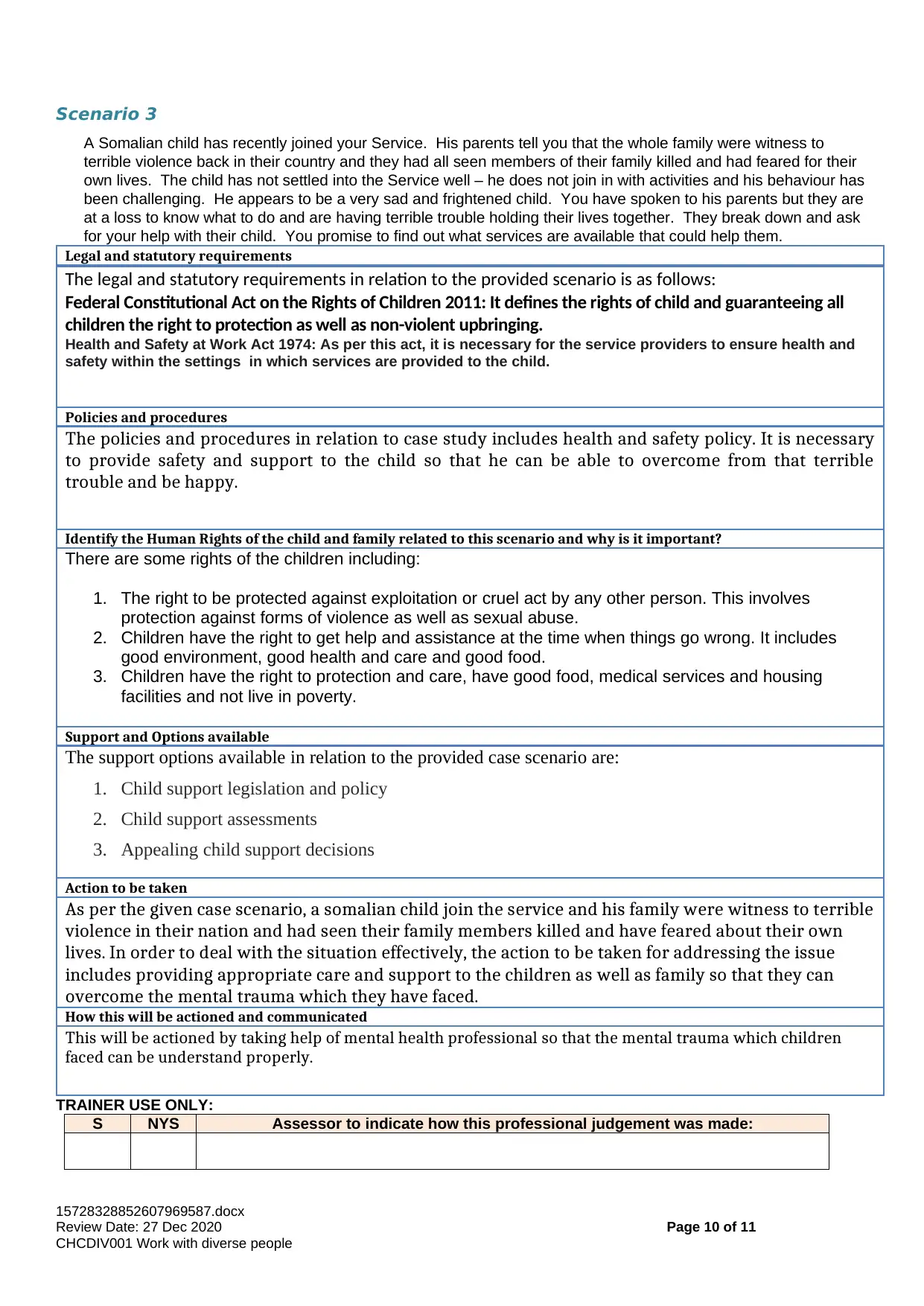
Scenario 3
A Somalian child has recently joined your Service. His parents tell you that the whole family were witness to
terrible violence back in their country and they had all seen members of their family killed and had feared for their
own lives. The child has not settled into the Service well – he does not join in with activities and his behaviour has
been challenging. He appears to be a very sad and frightened child. You have spoken to his parents but they are
at a loss to know what to do and are having terrible trouble holding their lives together. They break down and ask
for your help with their child. You promise to find out what services are available that could help them.
Legal and statutory requirements
The legal and statutory requirements in relation to the provided scenario is as follows:
Federal Constitutional Act on the Rights of Children 2011: It defines the rights of child and guaranteeing all
children the right to protection as well as non-violent upbringing.
Health and Safety at Work Act 1974: As per this act, it is necessary for the service providers to ensure health and
safety within the settings in which services are provided to the child.
Policies and procedures
The policies and procedures in relation to case study includes health and safety policy. It is necessary
to provide safety and support to the child so that he can be able to overcome from that terrible
trouble and be happy.
Identify the Human Rights of the child and family related to this scenario and why is it important?
There are some rights of the children including:
1. The right to be protected against exploitation or cruel act by any other person. This involves
protection against forms of violence as well as sexual abuse.
2. Children have the right to get help and assistance at the time when things go wrong. It includes
good environment, good health and care and good food.
3. Children have the right to protection and care, have good food, medical services and housing
facilities and not live in poverty.
Support and Options available
The support options available in relation to the provided case scenario are:
1. Child support legislation and policy
2. Child support assessments
3. Appealing child support decisions
Action to be taken
As per the given case scenario, a somalian child join the service and his family were witness to terrible
violence in their nation and had seen their family members killed and have feared about their own
lives. In order to deal with the situation effectively, the action to be taken for addressing the issue
includes providing appropriate care and support to the children as well as family so that they can
overcome the mental trauma which they have faced.
How this will be actioned and communicated
This will be actioned by taking help of mental health professional so that the mental trauma which children
faced can be understand properly.
TRAINER USE ONLY:
S NYS Assessor to indicate how this professional judgement was made:
15728328852607969587.docx
Review Date: 27 Dec 2020 Page 10 of 11
CHCDIV001 Work with diverse people
A Somalian child has recently joined your Service. His parents tell you that the whole family were witness to
terrible violence back in their country and they had all seen members of their family killed and had feared for their
own lives. The child has not settled into the Service well – he does not join in with activities and his behaviour has
been challenging. He appears to be a very sad and frightened child. You have spoken to his parents but they are
at a loss to know what to do and are having terrible trouble holding their lives together. They break down and ask
for your help with their child. You promise to find out what services are available that could help them.
Legal and statutory requirements
The legal and statutory requirements in relation to the provided scenario is as follows:
Federal Constitutional Act on the Rights of Children 2011: It defines the rights of child and guaranteeing all
children the right to protection as well as non-violent upbringing.
Health and Safety at Work Act 1974: As per this act, it is necessary for the service providers to ensure health and
safety within the settings in which services are provided to the child.
Policies and procedures
The policies and procedures in relation to case study includes health and safety policy. It is necessary
to provide safety and support to the child so that he can be able to overcome from that terrible
trouble and be happy.
Identify the Human Rights of the child and family related to this scenario and why is it important?
There are some rights of the children including:
1. The right to be protected against exploitation or cruel act by any other person. This involves
protection against forms of violence as well as sexual abuse.
2. Children have the right to get help and assistance at the time when things go wrong. It includes
good environment, good health and care and good food.
3. Children have the right to protection and care, have good food, medical services and housing
facilities and not live in poverty.
Support and Options available
The support options available in relation to the provided case scenario are:
1. Child support legislation and policy
2. Child support assessments
3. Appealing child support decisions
Action to be taken
As per the given case scenario, a somalian child join the service and his family were witness to terrible
violence in their nation and had seen their family members killed and have feared about their own
lives. In order to deal with the situation effectively, the action to be taken for addressing the issue
includes providing appropriate care and support to the children as well as family so that they can
overcome the mental trauma which they have faced.
How this will be actioned and communicated
This will be actioned by taking help of mental health professional so that the mental trauma which children
faced can be understand properly.
TRAINER USE ONLY:
S NYS Assessor to indicate how this professional judgement was made:
15728328852607969587.docx
Review Date: 27 Dec 2020 Page 10 of 11
CHCDIV001 Work with diverse people
Paraphrase This Document
Need a fresh take? Get an instant paraphrase of this document with our AI Paraphraser

END OF ASSESSMENT
15728328852607969587.docx
Review Date: 27 Dec 2020 Page 11 of 11
CHCDIV001 Work with diverse people
15728328852607969587.docx
Review Date: 27 Dec 2020 Page 11 of 11
CHCDIV001 Work with diverse people
1 out of 11
Related Documents
Your All-in-One AI-Powered Toolkit for Academic Success.
+13062052269
info@desklib.com
Available 24*7 on WhatsApp / Email
![[object Object]](/_next/static/media/star-bottom.7253800d.svg)
Unlock your academic potential
Copyright © 2020–2025 A2Z Services. All Rights Reserved. Developed and managed by ZUCOL.





